Heated Aeration for Nitrite-Oxidizing Bacteria (NOB) Control in Anammox-Integrated Membrane-Aerated Biofilm Reactors (MABR)
Abstract
:1. Introduction
2. Materials and Methods
2.1. Anammox–MABR Configuration
2.2. Experimental Methods
2.3. Quantifying Airflow Characteristics
2.4. 16S Amplicon Sequencing Methods
2.5. qPCR Methods
3. Results and Discussion
3.1. Anammox–MABR Performance
3.2. Oxygen Transfer through Membranes
3.3. Nitrogen Removal by Specific Bacterial Groups
3.4. Microbial Communities
4. Conclusions
Supplementary Materials
Author Contributions
Funding
Data Availability Statement
Conflicts of Interest
References
- Hu, Z.; Houweling, D.; Dold, P. Biological nutrient removal in municipal wastewater treatment: New Directions in Sustainability. J. Environ. Eng. 2012, 138, 307–317. [Google Scholar] [CrossRef]
- Rahimi, S.; Modin, O.; Mijakovic, I. Technologies for biological removal and recovery of nitrogen from wastewater. Biotechnol. Adv. 2020, 43, 107570. [Google Scholar] [CrossRef] [PubMed]
- Shourjeh, M.S.; Kowal, P.; Lu, X.; Xie, L.; Drewnowski, J. Development of strategies for AOB and NOB competition supported by mathematical modeling in terms of successful Deammonification implementation for energy-efficient wwtps. Processes 2021, 9, 562. [Google Scholar] [CrossRef]
- Walker, N.L.; Williams, A.P.; Styles, D. Pitfalls in international benchmarking of energy intensity across wastewater treatment utilities. J. Environ. Manag. 2021, 300, 113613. [Google Scholar] [CrossRef] [PubMed]
- Zhang, X.; Zhang, M.; Liu, H.; Gu, J.; Liu, Y. Environmental sustainability: A pressing challenge to Biological Sewage Treatment Processes. Curr. Opin. Environ. Sci. Health 2019, 12, 1–5. [Google Scholar] [CrossRef]
- Ge, H.; Batstone, D.J.; Keller, J. Operating aerobic wastewater treatment at very short sludge ages enables treatment and energy recovery through anaerobic sludge digestion. Water Res. 2013, 47, 6546–6557. [Google Scholar] [CrossRef] [PubMed]
- Cho, S.; Kambey, C.; Nguyen, V. Performance of Anammox Processes for wastewater treatment: A critical review on effects of operational conditions and environmental stresses. Water 2020, 12, 20. [Google Scholar] [CrossRef]
- Mulder, A.; Graaf, A.A.; Robertson, L.A.; Kuenen, J.G. Anaerobic ammonium oxidation discovered in a denitrifying fluidized bed reactor. FEMS Microbiol. Ecol. 1995, 16, 177–184. [Google Scholar] [CrossRef]
- Soliman, M.; Eldyasti, A. Ammonia-oxidizing bacteria (AOB): Opportunities and applications—A review. Rev. Environ. Sci. Bio/Technol. 2018, 17, 285–321. [Google Scholar] [CrossRef]
- Trinh, H.P.; Lee, S.-H.; Jeong, G.; Yoon, H.; Park, H.-D. Recent developments of the mainstream anammox processes: Challenges and opportunities. J. Environ. Chem. Eng. 2021, 9, 105583. [Google Scholar] [CrossRef]
- Ren, Z.-Q.; Wang, H.; Zhang, L.-G.; Du, X.-N.; Huang, B.-C.; Jin, R.-C. A review of anammox-based nitrogen removal technology: From Microbial Diversity to engineering applications. Bioresour. Technol. 2022, 363, 127896. [Google Scholar] [CrossRef] [PubMed]
- Landes, N.; Rahman, A.; Morse, A.; Jackson, W.A. Performance of a lab-scale membrane aerated biofilm reactor treating nitrogen dominant space-based wastewater through simultaneous nitrification-denitrification. J. Environ. Chem. Eng. 2021, 9, 104644. [Google Scholar] [CrossRef]
- Matsumoto, S.; Terada, A.; Tsuneda, S. Modeling of membrane-aerated biofilm: Effects of C/N ratio, biofilm thickness and surface loading of oxygen on feasibility of simultaneous nitrification and Denitrification. Biochem. Eng. J. 2007, 37, 98–107. [Google Scholar] [CrossRef]
- Zhang, K.; Wang, Z.; Sun, M.; Liang, D.; Hou, L.; Zhang, J.; Wang, X.; Li, J. Optimization of nitrogen and carbon removal with simultaneous partial nitrification, anammox and denitrification in membrane bioreactor. R. Soc. Open Sci. 2020, 7, 200584. [Google Scholar] [CrossRef] [PubMed]
- Bunse, P.; Orschler, L.; Agrawal, S.; Lackner, S. Membrane aerated biofilm reactors for mainstream partial nitritation/anammox: Experiences using real municipal wastewater. Water Res. X 2020, 9, 100066. [Google Scholar] [CrossRef] [PubMed]
- Ma, B.; Bao, P.; Wei, Y.; Zhu, G.; Yuan, Z.; Peng, Y. Suppressing nitrite-oxidizing bacteria growth to achieve nitrogen removal from domestic wastewater via ANAMMOX using intermittent aeration with low dissolved oxygen. Sci. Rep. 2015, 5, 13048. [Google Scholar] [CrossRef] [PubMed]
- Pathak, S.; Wang, S.; Janka, E. Achieving partial nitritation in anammox start-up environment. Water 2022, 14, 229. [Google Scholar] [CrossRef]
- Duan, H.; Ye, L.; Wang, Q.; Zheng, M.; Lu, X.; Wang, Z.; Yuan, Z. Nitrite oxidizing bacteria (NOB) contained in influent deteriorate mainstream nob suppression by sidestream inactivation. Water Res. 2019, 162, 331–338. [Google Scholar] [CrossRef] [PubMed]
- Kim, K.; Park, Y.-G. Light as a novel inhibitor of nitrite-oxidizing bacteria (NOB) for the mainstream partial nitrification of wastewater treatment. Processes 2021, 9, 346. [Google Scholar] [CrossRef]
- Kim, J.-H.; Guo, X.; Park, H.-S. Comparison study of the effects of temperature and free ammonia concentration on nitrification and nitrite accumulation. Process Biochem. 2008, 43, 154–160. [Google Scholar] [CrossRef]
- Ma, Y.; Domingo-Félez, C.; Plósz, B.G.; Smets, B.F. Intermittent aeration suppresses nitrite-oxidizing bacteria in membrane-aerated biofilms: A model-based explanation. Environ. Sci. Technol. 2017, 51, 6146–6155. [Google Scholar] [CrossRef] [PubMed]
- Lu, Y.; Liu, T.; Niu, C.; Duan, H.; Zheng, M.; Hu, S.; Yuan, Z.; Wang, H.; Guo, J. Challenges of suppressing nitrite-oxidizing bacteria in membrane aerated biofilm reactors by low dissolved Oxygen Control. Water Res. 2023, 247, 120754. [Google Scholar] [CrossRef] [PubMed]
- Niu, C.; Ying, Y.; Zhao, J.; Zheng, M.; Guo, J.; Yuan, Z.; Hu, S.; Liu, T. Superior mainstream partial nitritation in an acidic membrane-aerated biofilm reactor. Water Res. 2024, 257, 121692. [Google Scholar] [CrossRef] [PubMed]
- Mehrabi, S.; Houweling, D.; Dagnew, M. MABR process development downstream of a carbon redirection unit: Opportunities and challenges in Nitrogen Removal Processes. Environ. Technol. 2022, 44, 4084–4097. [Google Scholar] [CrossRef] [PubMed]
- Blackburne, R.; Yuan, Z.; Keller, J. Partial nitrification to nitrite using low dissolved oxygen concentration as the main selection factor. Biodegradation 2007, 19, 303–312. [Google Scholar] [CrossRef] [PubMed]
- Wu, J.; He, C.; van Loosdrecht, M.C.M.; Pérez, J. Selection of ammonium oxidizing bacteria (AOB) over nitrite oxidizing bacteria (NOB) based on conversion rates. Chem. Eng. J. 2016, 304, 953–961. [Google Scholar] [CrossRef]
- Li, J.; Feng, M.; Zheng, S.; Zhao, W.; Xu, X.; Yu, X. The membrane aerated biofilm reactor for nitrogen removal of wastewater treatment: Principles, performances, and Nitrous Oxide Emissions. Chem. Eng. J. 2023, 460, 141693. [Google Scholar] [CrossRef]
- Pourbavarsad, M.S.; Jalalieh, B.J.; Landes, N.; Jackson, W.A. Impact of free ammonia and free nitrous acid on nitritation in membrane aerated bioreactors fed with high strength nitrogen urine dominated wastewater. J. Environ. Chem. Eng. 2022, 10, 107001. [Google Scholar] [CrossRef]
- Krzeminski, P.; Iglesias-Obelleiro, A.; Madebo, G.; Garrido, J.M.; van der Graaf, J.H.J.M.; van Lier, J.B. Impact of temperature on raw wastewater composition and activated sludge filterability in full-scale MBR systems for Municipal Sewage treatment. J. Membr. Sci. 2012, 423–424, 348–361. [Google Scholar] [CrossRef]
- Alisawi, H.A. Performance of wastewater treatment during variable temperature. Appl. Water Sci. 2020, 10, 89. [Google Scholar] [CrossRef]
- Laureni, M.; Weissbrodt, D.G.; Villez, K.; Robin, O.; de Jonge, N.; Rosenthal, A.; Wells, G.; Nielsen, J.L.; Morgenroth, E.; Joss, A. Biomass segregation between biofilm and flocs improves the control of nitrite-oxidizing bacteria in mainstream partial nitritation and Anammox Processes. Water Res. 2019, 154, 104–116. [Google Scholar] [CrossRef] [PubMed]
- Chen, Z.; Zheng, X.; Chen, Y.; Wang, X.; Zhang, L.; Chen, H. Nitrite accumulation stability evaluation for low-strength ammonium wastewater by adsorption and biological desorption of zeolite under different operational temperature. Sci. Total Environ. 2020, 704, 135260. [Google Scholar] [CrossRef] [PubMed]
- Bougard, D.; Bernet, N.; Chèneby, D.; Delgenès, J.-P. Nitrification of a high-strength wastewater in an inverse turbulent bed reactor: Effect of temperature on nitrite accumulation. Process Biochem. 2006, 41, 106–113. [Google Scholar] [CrossRef]
- Cheng, S.; Xing, D.; Call, D.F.; Logan, B.E. Direct biological conversion of electrical current into methane by electromethanogenesis. Environ. Sci. Technol. 2009, 43, 3953–3958. [Google Scholar] [CrossRef] [PubMed]
- Lotti, T.; Kleerebezem, R.; van Loosdrecht, M.C.M. Effect of temperature change on ANAMMOX activity. Biotechnol. Bioeng. 2014, 112, 98–103. [Google Scholar] [CrossRef] [PubMed]
- De Almeida Fernandes, L.; Pereira, A.D.; Leal, C.D.; Davenport, R.; Werner, D.; Filho, C.R.; Bressani-Ribeiro, T.; de Lemos Chernicharo, C.A.; de Araújo, J.C. Effect of temperature on microbial diversity and nitrogen removal performance of an ANAMMOX reactor treating anaerobically pretreated municipal wastewater. Bioresour. Technol. 2018, 258, 208–219. [Google Scholar] [CrossRef] [PubMed]
- Baird, R.B.; Eaton, A.D.; Rice, E.W.; Bridgewater, L. Standard Methods for the Examination of Water and Wastewater, 23rd ed.; Section 2540 Solids; American Public Health Association, American Water Works Association, Water Environment Federation: Washington, DC, USA, 2017. [Google Scholar]
- Speth, D.R.; in’t Zandt, M.H.; Guerrero-Cruz, S.; Dutilh, B.E.; Jetten, M.S. Genome-based microbial ecology of anammox granules in a full-scale wastewater treatment system. Nat. Commun. 2016, 7, 11172. [Google Scholar] [CrossRef] [PubMed]
- Zhao, R.; Zhang, I.H.; Jayakumar, A.; Ward, B.B.; Babbin, A.R. Age, Metabolisms, and Potential Origin of Dominant Anammox Bacteria in the Global Oxygen Deficient Zones. ISME Commun. 2024, 4, ycae060. [Google Scholar] [CrossRef] [PubMed]
- Sonthiphand, P.; Neufeld, J.D. Evaluating primers for profiling anaerobic ammonia oxidizing bacteria within freshwater environments. PLoS ONE 2013, 8, e57242. [Google Scholar] [CrossRef] [PubMed]
- Schmid, M.; Twachtmann, U.; Klein, M.; Strous, M.; Juretschko, S.; Jetten, M.; Metzger, J.W.; Schleifer, K.-H.; Wagner, M. Molecular evidence for genus level diversity of bacteria capable of catalyzing anaerobic ammonium oxidation. Syst. Appl. Microbiol. 2000, 23, 93–106. [Google Scholar] [CrossRef] [PubMed]
- Schmid, M.; Walsh, K.; Webb, R.; Rijpstra, W.I.; van de Pas-Schoonen, K.; Verbruggen, M.J.; Hill, T.; Moffett, B.; Fuerst, J.; Schouten, S.; et al. Candidatus “Scalindua Brodae”, sp. nov., Candidatus “Scalindua Wagneri”, sp. nov., two new species of anaerobic ammonium oxidizing bacteria. Syst. Appl. Microbiol. 2003, 26, 529–538. [Google Scholar] [CrossRef] [PubMed]
- Xu, X.; Liu, G.; Fan, Q.; Chen, J.; Wang, Y.; Zhang, Y.; Yang, Y.; Wang, J.; Zhang, Y.; Jiang, H.; et al. Effects of gibberellin on the activity of anammox bacteria. J. Environ. Manag. 2018, 225, 104–111. [Google Scholar] [CrossRef] [PubMed]
- Dionisi, H.M.; Layton, A.C.; Harms, G.; Gregory, I.R.; Robinson, K.G.; Sayler, G.S. Quantification of Nitrosomonas oligotropha-like ammonia-oxidizing bacteria and Nitrospira spp. from full-scale wastewater treatment plants by competitive PCR. Appl. Environ. Microbiol. 2002, 68, 245–253. [Google Scholar] [CrossRef]
- Li, M.; Gu, J.-D. Advances in methods for detection of anaerobic ammonium oxidizing (anammox) bacteria. Appl. Microbiol. Biotechnol. 2011, 90, 1241–1252. [Google Scholar] [CrossRef]
- Stearns, J.C.; Davidson, C.J.; McKeon, S.; Whelan, F.J.; Fontes, M.E.; Schryvers, A.B.; Bowdish, D.M.E.; Kellner, J.D.; Surette, M.G. Culture and Molecular-Based Profiles Show Shifts in Bacterial Communities of the Upper Respiratory Tract That Occur with Age. ISME J. 2015, 9, 1246–1259. [Google Scholar] [CrossRef] [PubMed]
- Bartram, A.K.; Lynch, M.D.J.; Stearns, J.C.; Moreno-Hagelsieb, G.; Neufeld, J.D. Generation of Multimillion-Sequence 16S RRNA Gene Libraries from Complex Microbial Communities by Assembling Paired-End Illumina Reads. Appl. Environ. Microbiol. 2011, 77, 3846–3852. [Google Scholar] [CrossRef] [PubMed]
- Martin, M. Cutadapt Removes Adapter Sequences from High-Throughput Sequencing Reads. EMBnet. J. 2011, 17, 10. [Google Scholar] [CrossRef]
- Callahan, B.J.; McMurdie, P.J.; Rosen, M.J.; Han, A.W.; Johnson, A.J.A.; Holmes, S.P. DADA2: High-Resolution Sample Inference from Illumina Amplicon Data. Nat. Methods 2016, 13, 581–583. [Google Scholar] [CrossRef] [PubMed]
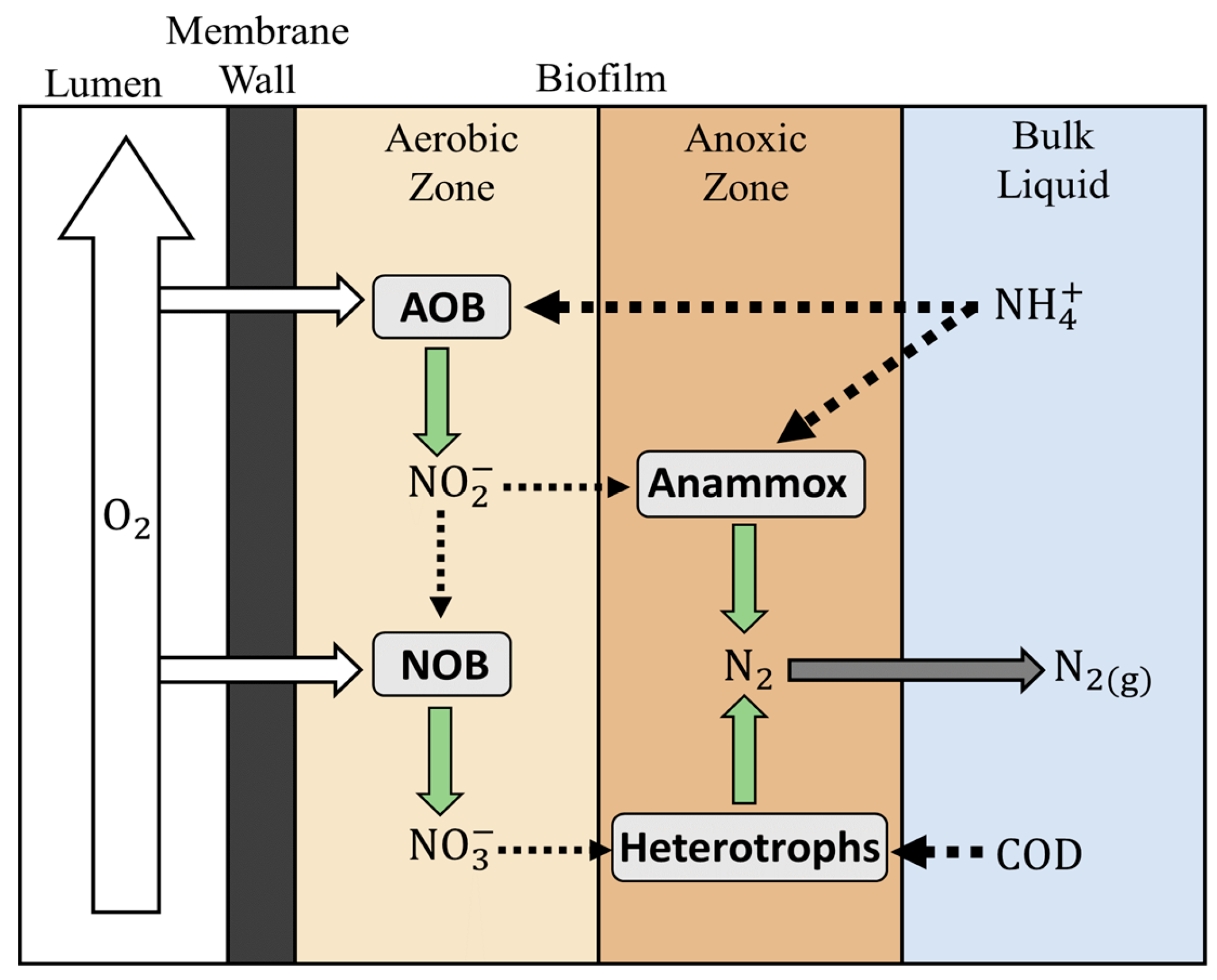
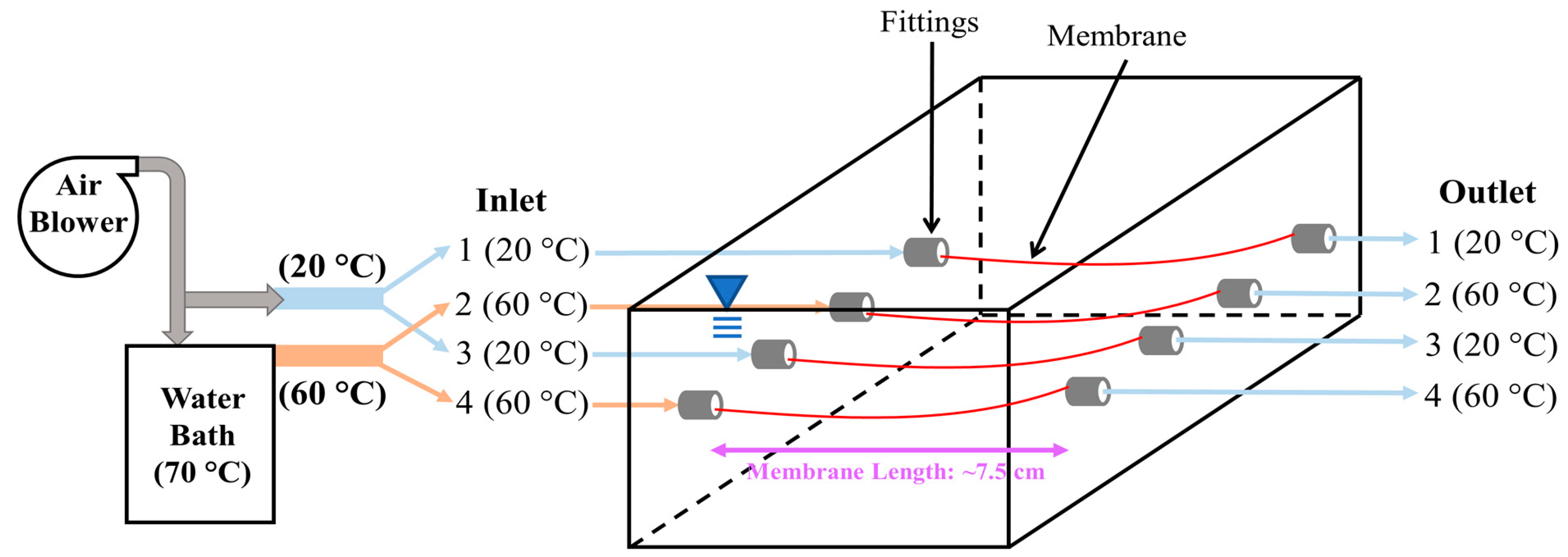
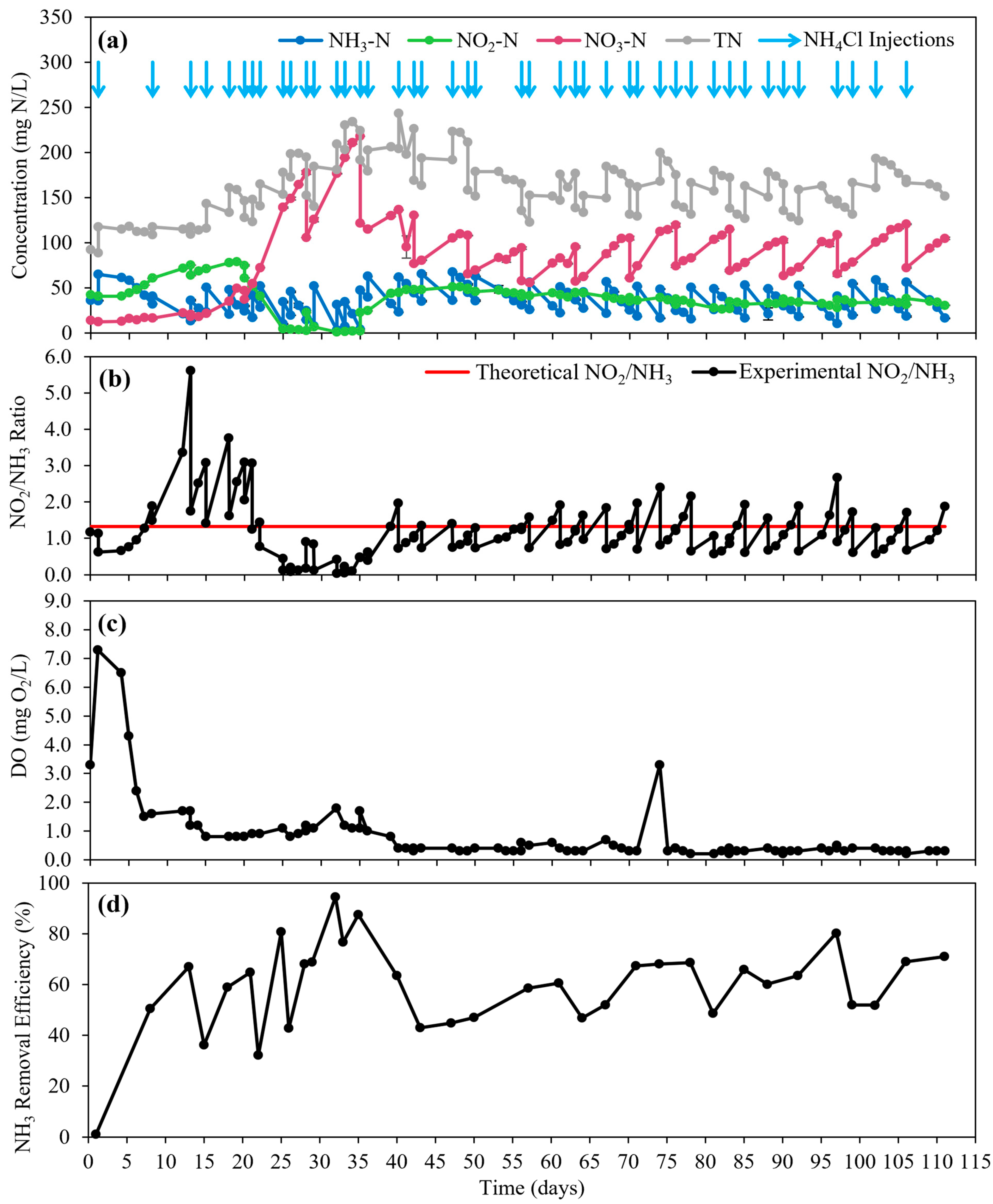
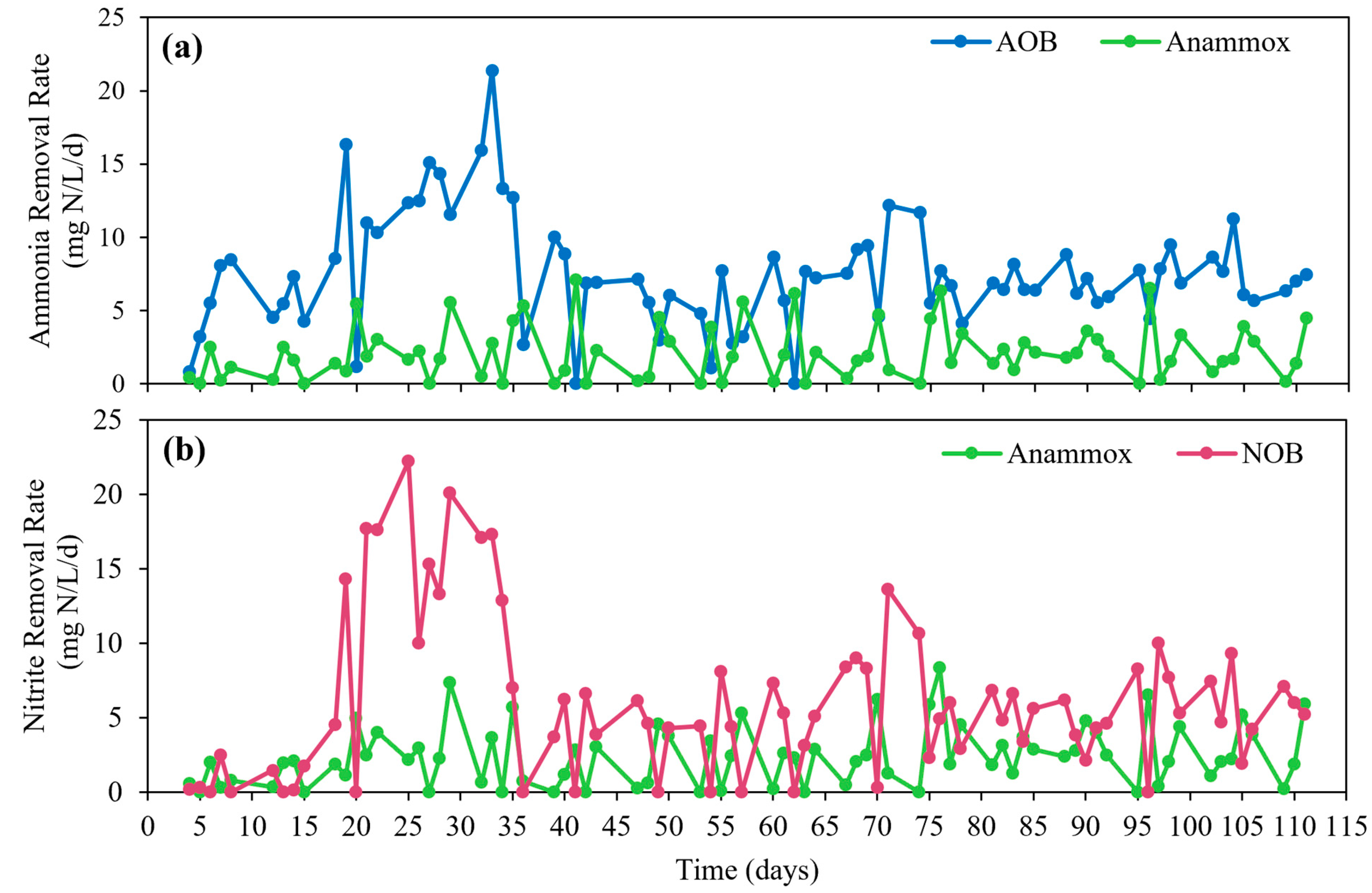
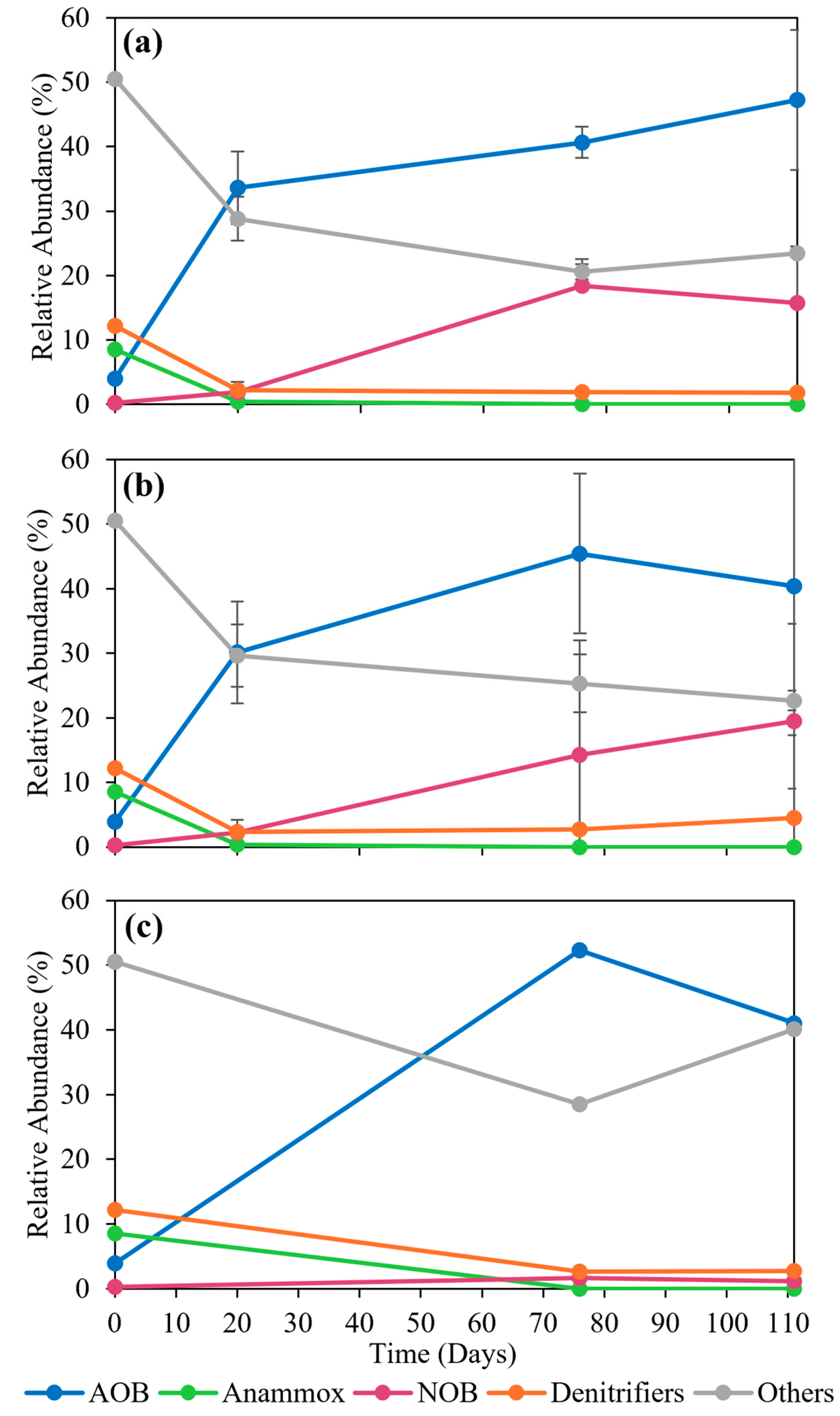
| Target | Primer | Sequence | Base Pair Length | References |
|---|---|---|---|---|
| General Bacteria | 16s rRNA 1055f 16s rRNA 1392r | 5′–ATG GCT GTC GTC AGCT–3′ 5′–ACG GGC GGT GTG TAC–3′ | 1392 bp | [40] |
| 1055 bp | ||||
| AOB | amoA-1f amoA-2r | 5′–GGG GTT TCT ACT GGT GGT–3′ 5′–CCC CTC KGS AAA GCC TTC TTC–3′ | 822 bp | [41,42] |
| 349 bp | ||||
| Anammox Bacteria | Amx 809f Amx 1066r | GCC GTA AAC GAT GGG CACT AAC GTG TCA CGA CAC GAG CTG | 1066 bp | [43] |
| 809 bp | ||||
| Amx 368f Amx 820r | 5′–TTC GCA ATG CCC GAA AGG–3′ 5′–AAA ACC CCT CTA CTT AGT GCCC–3′ | 820 bp | [40,41,42] | |
| 368 bp | ||||
| NOB | NSR 113f NSR 1264r | 5′–CCT GCT TTC AGT TGC TAC CG–3′ 5′–GTT TGC AGC GCT TTG TAC CG–3′ | 1264 bp | [44] |
| 1113 bp |
| Target | Primer | Hold | Denaturation | Annealing | Extension * | Hold |
|---|---|---|---|---|---|---|
| General Bacteria | 16s rRNA 1055f 16s rRNA 1392r | 95 °C 5 min | 95 °C 45 s | 55 °C 30 s | 72 °C 30 s | 72 °C 5 min |
| AOB | amoA-1f amoA-2r | 95 °C 5 min | 95 °C 45 s | 55 °C 45 s | 72 °C 1 min | 72 °C 5 min |
| Anammox Bacteria | Amx 809f Amx 1066r | 95 °C 5 min | 94 °C 20 s | 55 °C 20 s | 72 °C 20 s | 72 °C 5 min |
| Amx 368f Amx 820r | 95 °C 5 min | 95 °C 45 s | 59 °C 45 s | 72 °C 45 s | 72 °C 5 min | |
| NOB | NSR 113f NSR 1264r | 95 °C 5 min | 94 °C 30 s | 65 °C 30 s | 72 °C 30 s | 72 °C 5 min |
| Target | Primer | Hold | Denaturation | Annealing | Extension * |
|---|---|---|---|---|---|
| General Bacteria | 16s rRNA 1055f 16s rRNA 1392r | 95 °C 2 min | 98 °C 5 s | 55 °C 30 s | 72 °C 30 s |
| AOB | amoA-1f amoA-2r | 95 °C 3 min | 95 °C 30 s | 55 °C 30 s | 72 °C 45 s |
| Anammox Bacteria | Amx 809f Amx 1066r | 94 °C 30 s | 94 °C 10 s | 55 °C 15 s | 72 °C 15 s |
| Amx 368f Amx 820r | 98 °C 2 min | 98 °C 5 s | 59 °C 30 s | 72 °C 30 s | |
| NOB | NSR 113f NSR 1264r | 95 °C 3 min | 95 °C 30 s | 53 °C 30 s | 72 °C 30 s |
| Condition | Day 0 to Day 35 | Day 35 to Day 111 | ||
|---|---|---|---|---|
| Effluent Air Linear Velocity (cm/s) | Residence Time, τair (s) | Effluent Air Linear Velocity (cm/s) | Residence Time, τair (s) | |
| 20 °C—A | 32.25 ± 4.81 | 0.23 ± 1.56 | 8.24 ± 2.04 | 0.91 ± 3.68 |
| 20 °C—B | 17.30 ± 3.78 | 0.43 ± 1.98 | 4.94 ± 1.35 | 2.12 ± 18.02 |
| 60 °C—A | 4.71 ± 2.66 | 1.59 ± 2.81 | 3.53 ± 0.42 | 1.52 ± 5.54 |
| 60 °C—B | 5.06 ± 4.78 | 1.48 ± 1.57 | 6.24 ± 1.69 | 1.20 ± 4.44 |
| Condition | General | AOB | Anammox (AMX809f/1066r) | Anammox (AMX368f/820r) | NOB |
|---|---|---|---|---|---|
| Copies/ng DNA/cm2 Membrane | |||||
| 20 °C | 2,837,799 | 720,616 | 23,344 | 38 | 1196 |
| 60 °C | 1,909,612 | 647,375 | 25,293 | 62 | 3123 |
Disclaimer/Publisher’s Note: The statements, opinions and data contained in all publications are solely those of the individual author(s) and contributor(s) and not of MDPI and/or the editor(s). MDPI and/or the editor(s) disclaim responsibility for any injury to people or property resulting from any ideas, methods, instructions or products referred to in the content. |
© 2024 by the authors. Licensee MDPI, Basel, Switzerland. This article is an open access article distributed under the terms and conditions of the Creative Commons Attribution (CC BY) license (https://creativecommons.org/licenses/by/4.0/).
Share and Cite
Shiu, N.; Guo, H.; Kim, Y. Heated Aeration for Nitrite-Oxidizing Bacteria (NOB) Control in Anammox-Integrated Membrane-Aerated Biofilm Reactors (MABR). Environments 2024, 11, 155. https://doi.org/10.3390/environments11070155
Shiu N, Guo H, Kim Y. Heated Aeration for Nitrite-Oxidizing Bacteria (NOB) Control in Anammox-Integrated Membrane-Aerated Biofilm Reactors (MABR). Environments. 2024; 11(7):155. https://doi.org/10.3390/environments11070155
Chicago/Turabian StyleShiu, Natalia, Hui Guo, and Younggy Kim. 2024. "Heated Aeration for Nitrite-Oxidizing Bacteria (NOB) Control in Anammox-Integrated Membrane-Aerated Biofilm Reactors (MABR)" Environments 11, no. 7: 155. https://doi.org/10.3390/environments11070155








